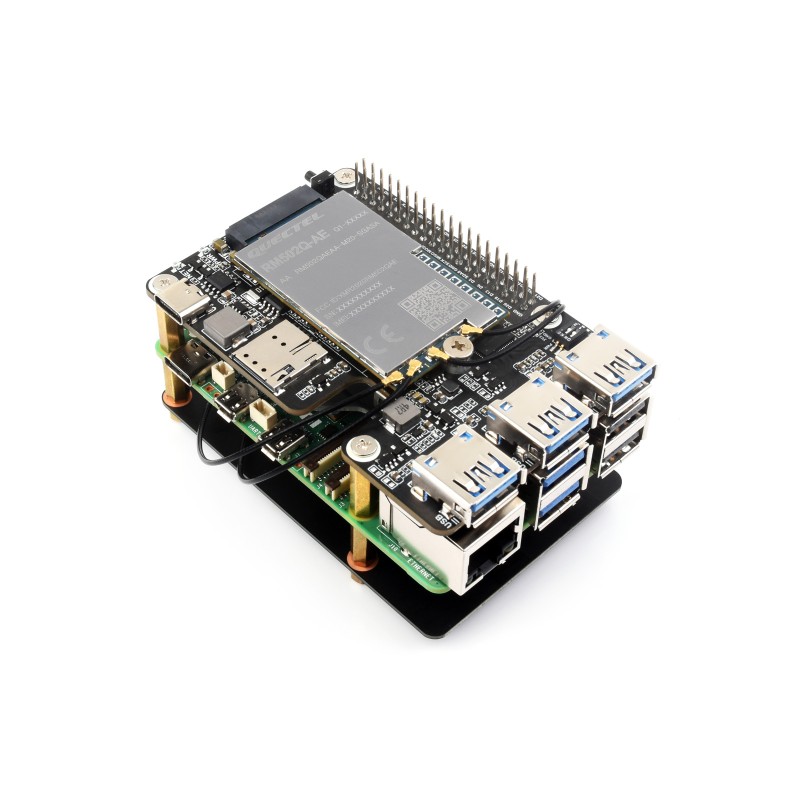






zł118.39 tax excl.
The PCIe HAT for 4G/5G modems and USB 3.2 Gen1 enables integration of high-speed cellular connectivity and USB port expansion in Raspberry Pi 5 projects. It supports M.2 Key B standard modems, ensuring compatibility with a wide range of frequencies and SIM card formats. The built-in power monitoring system and HAT+ compliance allow for advanced power management. Ideal for use in industrial routers, IoT gateways, mobile communication systems, and projects requiring fast 4G/5G network access.
Expansion HAT for Raspberry Pi 5 enabling support for 4G/5G modems with an M.2 Key B interface and adding three USB 3.2 Gen1 ports. Compatible with SIMCom and Quectel modules in 3042 and 3052 form factors, including SIM7600XX-M.2, SIM82XX, and RM5XX series. Features an integrated Nano-SIM card slot, USB-C port for power supply, firmware updates, and PC connection, as well as a GPIO connector for extending Raspberry Pi functionality. The INA219 measurement chip allows real-time power monitoring. Includes a 5G-4IN1 PCB antenna. The HAT is compliant with the HAT+ standard and includes an EEPROM for board identification.
Manufacturer BTC Korporacja sp. z o. o. Lwowska 5 05-120 Legionowo Poland sprzedaz@kamami.pl 22 767 36 20
Responsible person BTC Korporacja sp. z o. o. Lwowska 5 05-120 Legionowo Poland sprzedaz@kamami.pl 22 767 36 20
SIM7000E NB-IoT HAT is a module that extends the capabilities of Raspberry Pi for communication via GSM / GPRS cellular networks based on Simcom Sim7000E. It has support for NB-IoT, eMTC, EDGE, GPRS and GNSS. Waveshare SIM7000E NB-IoT HAT
Set with SIMCom 5G SIM8262E-M2 module designed to work with the Raspberry Pi minicomputer. It supports 5G SA or NSA networks and is backward compatible with 4G and 3G networks. Waveshare SIM8262E-M2 5G HAT
No product available!
KAmodRPi-GPRS-GPS is an overlay for Raspberry Pi 4 / 3B + / 3B / 2B / B + computers, which allows you to enrich the system with the ability to send data via GPRS, SMS transmission or work as a module for Bluetooth communication. This extension also offers the ability to receive satellite data from location systems - GPS and GLONASS.
Expansion board with LoRa E22-400T22S module for Raspberry Pi. It supports the LoRaWAN protocol and allows communication in the 433 MHz frequency band. Waveshare SX1268 433M LoRa HAT
No product available!
PCIE TO 4-CH NVME Board (B) NP is a PCIe expansion board for Raspberry Pi 5, allowing connection of up to four NVMe drives, improving system performance and enabling SSD boot. With power supply via Pi5 or an external source and support for multiple M.2 formats, it is ideal for expanding storage in projects requiring high speed and reliability. Version without power adapter and power cable, intended for users with their own power infrastructure.
No product available!
The KAmodRPi5 PCIe-M.2 adapter allows you to easily connect an NVME SSD to a Raspberry Pi 5 computer, ensuring universal installation, communication via the PCI Express interface, stable power supply voltage and LED indicators, while maintaining compatibility with HAT modules and official cooling
The PCIe TO M.2 HAT+ Acce B kit with a 256 GB SSD expands the functionality of the Raspberry Pi 5 by providing fast data storage and the ability to boot the system from an NVMe drive. With high compatibility, built-in power monitoring, and a compact design, the kit is ideal for server projects, file systems, edge computing applications, and solutions requiring high read/write speeds.
No product available!
Adapter in the form of a HAT+ cover for Raspberry Pi 5 enabling the connection of drives, AI accelerators and other modules in the M.2 standard with an M key. The board supports drives in the 2230 and 2242 format and provides transfer speeds of up to 500 MB/s. Raspberry Pi SC1166
HAT module designed for Raspberry Pi minicomputer. Powala adds two CAN interfaces to the project. Waveshare 2-CH CAN HAT
No product available!
NVMe Base is a reliable solution for expanding storage for the Raspberry Pi 5, ideal for users who require fast data access and large storage capacity. With support for multiple NVMe SSD models and compatibility with the Raspberry Pi 5, it is the perfect addition to projects that demand performance and flexibility. Pimoroni PIM699
No product available!
Expansion board with LoRaWAN SX1303 and GNSS L76B dedicated to the Raspberry Pi. The kit includes the 868M antenna, GPS and cables. Waveshare SX1303 868M LoRaWAN Gateway HAT
No product available!
The module with the converter USB-UART CP2104 dedicated for minicomputers Raspberry Pi. Adafruit 3589
The set with the RM500Q-GL module is designed to work with the Raspberry Pi minicomputer. It supports 5G, 4G and 3G networks and supports GNSS positioning. Waveshare RM500Q-GL 5G HAT (EU)
No product available!
3-port HUB module with USB 2.0 interface with RJ45 connector with PoE function. Designed for Raspberry Pi Zero. Case included. Waveshare PoE-ETH-USB-HUB-BOX
KAmod RPi5 M.2 mini allows you to connect NVMe M.2 drives, which allows you to use it as a multimedia center or file server, while maintaining a small size and low power consumption
Module with an RFID reader designed to work with the Raspberry Pi. Equipped with an OLED display and a buzzer. SB Components 20003

The PCIe HAT for 4G/5G modems and USB 3.2 Gen1 enables integration of high-speed cellular connectivity and USB port expansion in Raspberry Pi 5 projects. It supports M.2 Key B standard modems, ensuring compatibility with a wide range of frequencies and SIM card formats. The built-in power monitoring system and HAT+ compliance allow for advanced power management. Ideal for use in industrial routers, IoT gateways, mobile communication systems, and projects requiring fast 4G/5G network access.
